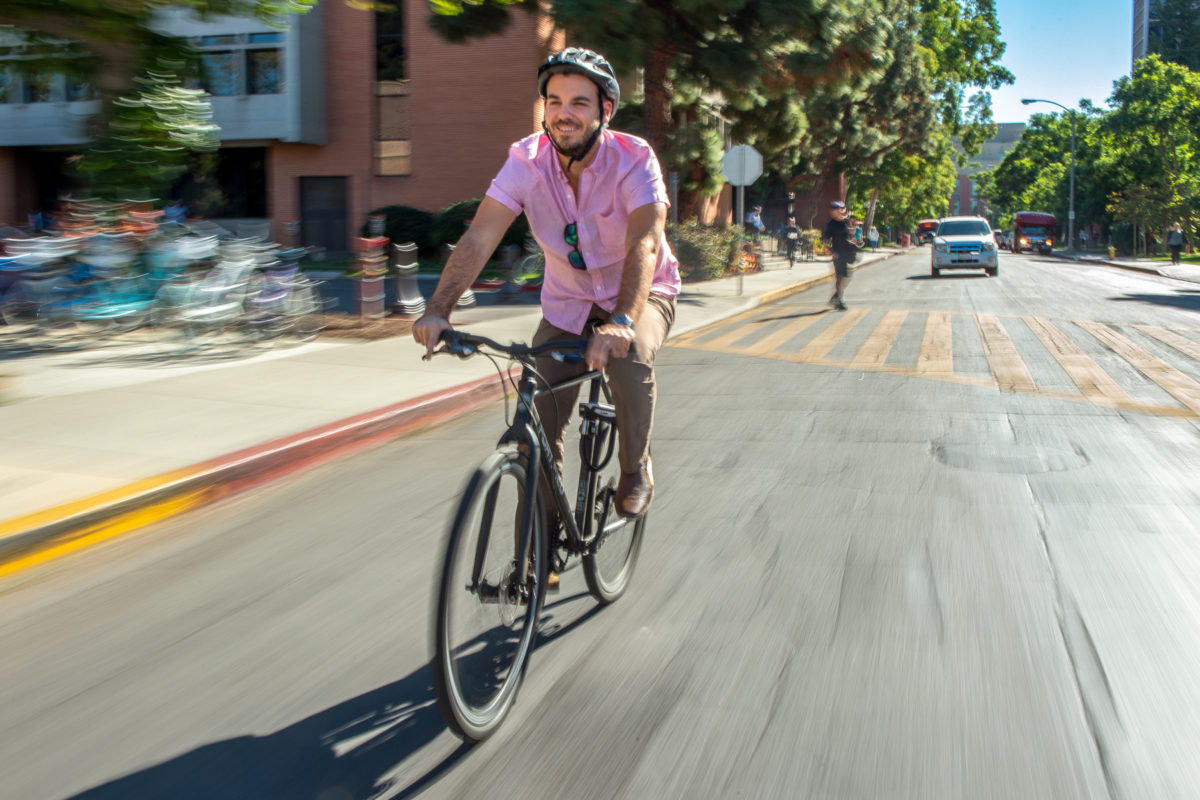
What’s it like to bike to work in Los Angeles?
At first, the idea of biking to work in Los Angeles felt bold and a bit risky. It certainly raised eyebrows when I pitched the possibility to friends and coworkers. But now, after seven months of commuting to USC on two wheels, I’ve found it’s a great way to stretch my legs, take advantage of great weather and view the unseen connective tissue that holds L.A. together.
I started working just east of the USC University Park Campus in March and began traveling to the office via the Metro Expo Line from downtown’s 7th Street/Metro Center stop. I’ve lived in L.A. for more than two years without a car, so getting a job within striking distance of my apartment meant I could likely keep up that lifestyle. But after a month of walking the half-mile to the station and waiting patiently for the train to arrive, I began to wonder if there was another way.
I’ve always wanted to get a bike, I thought to myself.
Despite investments, L.A. does not bike to work
This is an uncommon sentiment in Los Angeles. Though California has the fourth most bike-to-work commuters in the United States, the 2014 census found that only 1% of commuters in L.A. bike to the office. Most use cars: In 2018, USC faculty and staff drove alone to and from work 28,084 times, according to USC Transportation. Comparatively, there were only 3,233 one-way bike trips in 2018, down significantly from 5,597 in 2015.
This is despite L.A. beginning to invest in its bike infrastructure through bike lane improvements and expansions of its Metro Bike Share program, though many call those investments inadequate given the city’s size and distinct reliance on car travel. The first two-way protected lane opened on downtown’s Spring Street in April, and the MyFigueroa project was designed to build a safe thoroughfare from downtown to South L.A. – though its unveiling in August 2018 was met with “muted applause.” Both have been useful for DTLA residents who commute to the USC University Park Campus like me, but neither drastically changed how Angelenos move around the city.
“What we need is a complete, connected network,” said Colin Bogart, education director at the Los Angeles County Bicycle Coalition. “If you pull up Los Angeles on Google Maps and click the bike icon, you’ll see a series of unconnected lines. If we paved our roads that way, people wouldn’t drive. So why is anyone surprised that people aren’t biking?”
The ups and downs of biking in L.A.
Predictably, this incomplete, disconnected network carries risks. According to the Los Angeles Times, 10 cyclists died in traffic collisions in L.A. in 2013. Since then, Mayor Eric Garcetti’s Vision Zero initiative has aimed to eliminate them — yet 21 cyclists died in traffic in 2018. While Los Angeles is one of many cities attempting to balance traffic concerns with pedestrian and biker safety, it does make a new cyclist wonder if the risk is worth the reward.
I’m not going to lie; I’ve already been hit by a car, and I’ve taken a serious tumble on my way to the office. But both were learning experiences; I’ve been far more cautious and stuck to safe bike lanes ever since.
Still, there are undeniable benefits to my bike-to-work life. My commute each way is now exactly 25 minutes, which makes it easier to plan my mornings and evenings. Paying $1.75 for a ride on the Expo Line isn’t bad, but it can’t beat a free ride on a bike. Now that the summer is over, the 3-mile journey down Figueroa Street has become a breezy treat as opposed to a sweaty slog. And I’ve lost 15 pounds since I started riding; although I used to be a serious spin class attendee, there’s apparently no substitute for the real thing.
I remain a dedicated bus and train rider, and I love that USC’s renewed public transit subsidy program may entice faculty and staff to consider commuting options beyond hopping in their cars. I’m also optimistic that increased community interest in bike and scooter safety campaigns like Sunset4All will spur more conversation and political action. If the immensely popular CicLAvia festival is any indication, thousands of Angelenos will get on their bikes and ride if their paths are protected.
“If you want bike riding to be a viable option,” Bogart said, “it has to be easy and people have to feel safe doing it.”
Despite the complications that come with biking to work in L.A., I haven’t once regretted my commitment to those two wheels. I love not being at the whim of Metro service or unexpected delays. I love discovering the little shops and restaurants between train stations. And I love knowing, in some small way, I’m helping L.A. transition from a car culture to a city that embraces all modes of hauling yourself around this massive town.